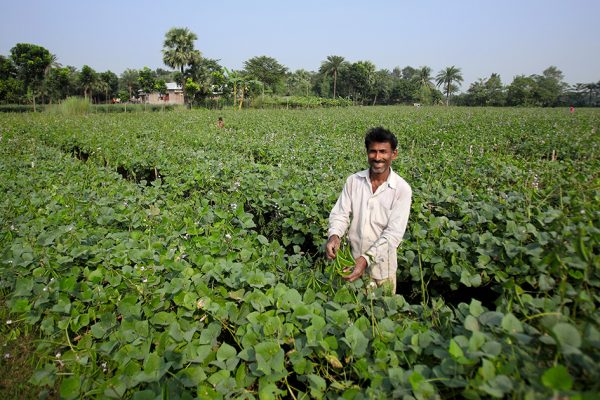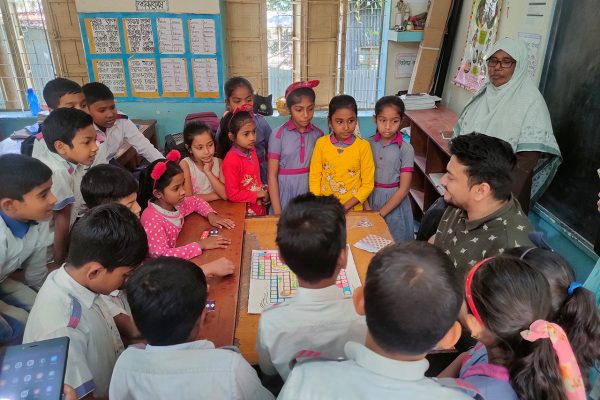The MasterCard Foundation: Women Driving Change
Reading Time: 3 minutes
Below is a post from Reeta Roy, President & CEO of the MasterCard Foundation. She is currently visiting BRAC’s programs in Uganda along with other members of the MasterCard team. She wrote this after visiting one of BRAC’s microfinance groups.
Below is a post from Reeta Roy, President & CEO of the MasterCard Foundation. She is currently visiting BRAC’s programs in Uganda along with other members of the MasterCard team. She wrote this after visiting one of BRAC’s microfinance groups.
Today, we met with women who are members of a BRAC microfinance group in Bukalaza. This village is situated in a rural community about 1.5 hours drive north of Kampala. The women we came to know are creating change on multiple levels — in their own lives, in the lives of their families and in their communities.
Learning from Sarah
During the day, we got to know Sarah Namugenyi, the microfinance branch manager for the area as she accompanied us during our visits to clients and their homes. Sarah is a fresh university graduate who studied business, when she was recruited and trained by BRAC two years ago. She is 24 years old and has already demonstrated leadership and a maturity beyond her years. She currently supervises four credit officers. Her team serves 67 microfinance groups or about 1700 members.
Every day, a credit officer meets with three microfinance groups. In this rural area, the roads are unpaved and BRAC staff typically reach the villages on foot.
As we reviewed monthly goals and performance (a chart that tracks performance is posted prominently in each branch office), we noted that Sarah’s team had exceeded its targets in September.
What explains the results? Sarah smiled, “We don’t aim for the target, we have to aim higher.”
Bukalaza Women Grow Their Businesses
We listened intently as the women of this microfinance group began their meeting by reciting the ten principles of BRAC’s group membership. The principles range from keeping sizes of families small to helping others and showing up on time at weekly meetings.
As loan repayments were collected, we heard from each of the 21 women about how they were growing their businesses. Most of them were already on their third loans. Their stories reflected an innate savvy and creativity about how to diversify their businesses and income streams, while building assets in goats and cows as well as in land, houses and motorbikes.
Several of the women noted that their third loans were often smaller than the previous two. This is an indication of their success in generating profits from their current businesses and pragmatism about not assuming more debt than needed.
Edith, a maize farmer, told us that she used her first loan of 400,000 Ugandan Shillings (approximately US$200) to buy poultry. Her second loan of 500,000 Ugandan Shillings expanded the number of birds. With profits from her business and her third loan of 400,000 Ugandan Shillings, she bought a motorbike, which she rents out as a taxi.
Harriet used her first two loans to invest in feed for her poultry and to buy a cow. The cow has since produced two calves. Her third loan, only 100,000 Ugandan Shillings, was used to buy coffee beans. “My cow is producing milk that I sell. I don’t need a bigger loan right now.”
Aishah runs a small canteen and sells pineapples. Her first loan helped her “book” a garden that grows pineapples in order to guarantee a steady supply of product to sell. She is used profits generated by her previous two loans and a third loan to purchase a cow and a motorbike.
Others like Flavia, Madina and Khatijah – whether they were raising chickens, selling sugarcane or running a hair salon – explained they were using profits to buy land, build better homes or to expand their shops.
Nearly all of the women spoke about using their income to pay for school fees for their children and to feed their families.
We asked if anyone had opened savings accounts at nearby banks. A few had. However, they preferred to access loans from BRAC. “The interest rates of banks are still high and the repayment time is shorter.” This was a consistent observation.
The women also valued the livelihoods training and services that BRAC provided in the agriculture and livestock sectors. Theresa, an older lady and her face lined with many stories said, “I’ll stay with BRAC. I like the staff. They encourage us and treat us with respect. I feel more comfortable accessing a loan here.”
So, how else can BRAC better serve them? There was no shortage of suggestions: “How about a housing loan? My husband would like to join the group! Will you start a group for men?” Everyone wants BRAC to offer savings.
All of these suggestions are opportunities to explore as we look to forward to expanding our partnership in Uganda.





